 Sister ship Chacal turning
| |
| History | |
|---|---|
| Name | Lynx |
| Namesake | Lynx |
| Ordered | 26 February 1923 |
| Builder | Ateliers et Chantiers de la Loire, Nantes |
| Laid down | 14 January 1924 |
| Launched | 24 February 1925 |
| Completed | 18 October 1927 |
| In service | 15 November 1927 |
| Out of service | July 1940 |
| Fate | |
| General characteristics (as built) | |
| Class and type | Chacal-class destroyer |
| Displacement | |
| Length | 126.8 m (416 ft 0.1 in) |
| Beam | 11.1 m (36 ft 5.0 in) |
| Draft | 4.1 m (13 ft 5.4 in) |
| Installed power |
|
| Propulsion |
|
| Speed | 35.5 knots (65.7 km/h; 40.9 mph) |
| Range | 3,000 nmi (5,600 km; 3,500 mi) at 15 knots (28 km/h; 17 mph) |
| Crew | 12 officers, 209 crewmen (wartime) |
| Armament |
|
The French destroyer Lynx was a Chacal-class destroyer (contre-torpilleur) built for the French Navy during the 1920s. The Chacals were regarded as obsolete by 1935 and Lynx became a training ship for the torpedo school at Toulon that year. She was assigned convoy escort duties in the Atlantic after the start of World War II in September 1939. In July 1940, the ship was present when the British attacked the French ships at Mers-el-Kébir, but managed to escape without damage. After she reached Toulon, Lynx was placed in reserve where she remained for the next two years. On 27 November 1942, she was scuttled at Toulon when the Germans attempted to capture the French ships there. Her wreck was salvaged in 1944, but she was not broken up until 1948.